Ah, January. Not much going on in the garden. Witch hazels are blooming, and a few camellias. In colder zones, there’s nothing blooming at all. It was -16°F last Monday in my hometown in Minnesota. The record for that day is -42°F.
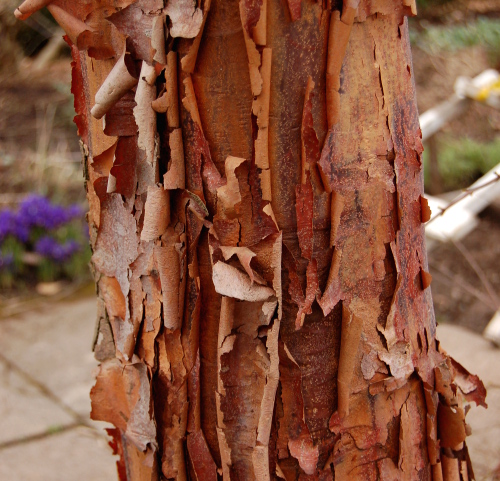
Bark takes center stage this time of year as we look harder to find beauty in the landscape. Luckily, there are many trees with gorgeous bark to bring joy to the winter garden. I’d like to share a few of my favorites, including some uncommon ones.

I saw this incredible Tanyosho pine (Pinus densiflora ‘Tanyosho’ or ‘Umbraculifera’) at the Portland Community College Rock Creek campus one fall day (at HPSO’s annual Plant Fest).
The Asian Tanyosho pine grows very slowly into a mushroom-shaped tree and is sometimes called “tabletop pine” for its flat-topped canopy. Conifers often look goofy if you limb them up, but this one grows naturally in a manner that exposes the sexy bark. It’s hardy to zone 4.

Birch-bark or paper-bark cherry (Prunus serrula) will make you weak in the knees. This venerable old specimen is at the Hoyt Arboretum in Portland.
Birch-bark cherry is kind of a Goldilocks tree, preferring climates that aren’t too hot in summer or too cold in winter. It’s rather susceptible to borers and other pests, and it might not live that long. But if you can keep it happy, there’s no sight easier on winter-weary eyes.

Dancing Oaks Nursery in Monmouth, Oregon has this to say about Prunus serrula: “Easily one of the most superb bark trees to be had. Polished rings of mahogany bark exfoliate and become sunlit amber orange shards.” Here’s their full description and some other nurseries that grow it.
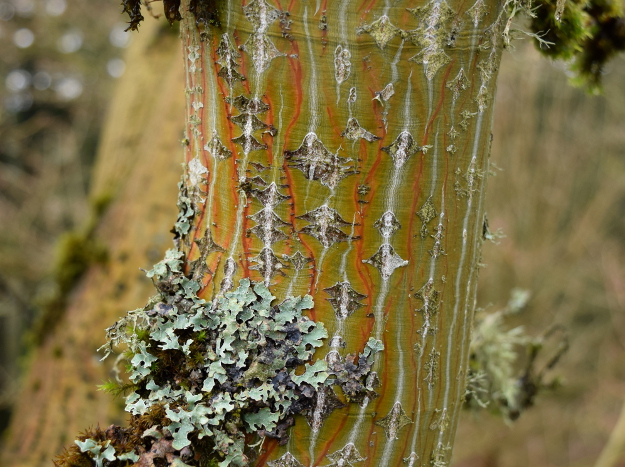
While exploring Hoyt Arboretum today, I came across a type of “snakebark” maple, Acer rufinerve ‘Albolimbatum’. A. rufinerve is also known as redvein maple, and the cultivar ‘Albolimbatum’ is a variegated form. Redvein maple is hardy to zone 5 and also prefers cool summers.

Redvein’s pinstripes reminded me of the Acer tegmentosum ‘Joe Witt’ that I saw at Nancy Buley’s Treephoria nursery. The Manchurian striped maple, as this species is known, is another type of snakebark maple. I believe it’s a little less fussy than some of the others can be.

And here’s another snakebark, Acer ×conspicuum ‘Phoenix’, which I saw at Portland Nursery a couple of years ago.

If that’s not enough for you—and if that isn’t enough for you, then you’re impossible to please, and I pity the people that have to shop for you—’Phoenix’ has hot pink-red buds. *Swoon*

The snakebark maples tend to lose some bark appeal as they age, but there are other trees whose bark gets better with age. This is a common persimmon (Diospyros virginiana) at Spring Grove Cemetery in Cincinnati. With age comes this fantastic snow-tire-tread bark, and on female plants, orange or purple fruits that are the world’s most delectable natural sugar rush.

I always loved visiting the grove of shagbark hickories (Carya ovata) at Mt. Airy Arboretum in Cincinnati. Native to the eastern U.S., shagbark hickory is more often a “saved” tree than a planted one. It quickly develops a taproot, and not many nurseries want to mess with it. It’s also a super-slow grower; a 100-year-old tree may be only 12 inches in diameter. But that bark! And fabulous golden fall color and tasty nuts.
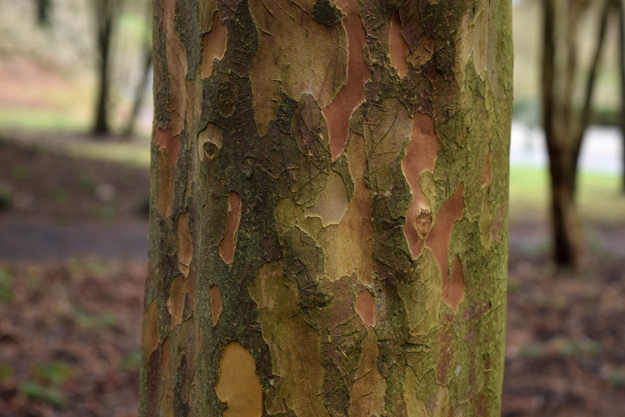
Back in Portland, at the Hoyt Arboretum, I also visited the lovely stewartia collection there. Most gardeners are familiar with Japanese stewartia (Stewartia pseudocamellia) and its peach/olive/gray/taupe/mustard patchwork bark. This is an exquisite four-season plant with white flowers in summer and orange-red fall color. It likes light shade and woodsy soil and does best in zones 5 to 7 (and zone 8 on the West Coast).

Korean stewartia (Stewartia koreana) is very similar to Japanese stewartia, but I think its bark is even showier—at least the examples I saw of it were.
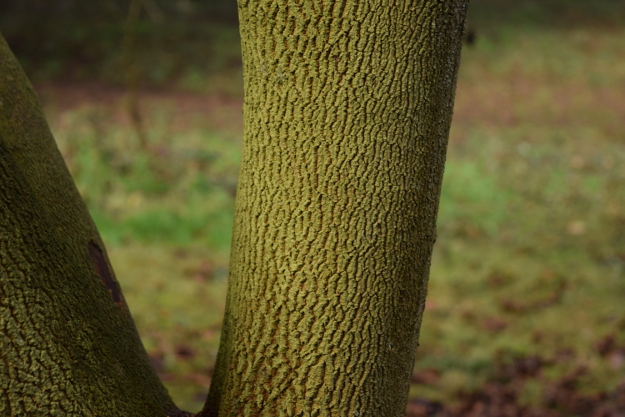
Upright stewartia (Stewartia rostrata) is a Chinese species whose bark looks nothing like its cousins’. Though its bark doesn’t exfoliate, it does show an interesting pattern—like the finely netted rind of a cantaloupe. Dirr says S. rostrata is more heat tolerant than S. pseudocamellia or S. koreana.
 Any guesses what this is? Haha. I think this is a bigleaf maple.
Any guesses what this is? Haha. I think this is a bigleaf maple.
I may get hate mail for saying this, but I’m not crazy about all the moss and lichens that grow on everything in the Pacific Northwest. I know it’s supposed to add a natural, lush, antique-y look, but it’s a little much. I kind of want to scrape it off so I can see the bark!

Kousa dogwood (Cornus kousa) is known mostly for its lovely white (sometimes pink) flowers, edible red fruits, fiery fall color, and resistance to dogwood anthracnose, but you can add amazing jigsaw-puzzle bark to its list of attributes. I found this especially showy example hanging out in a parking strip in Portland.
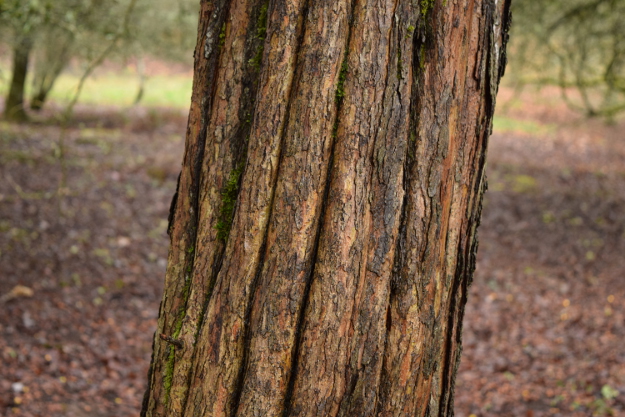
Pear hawthorn (Crataegus calpodendron) at the Hoyt Arboretum was a new one to me, and its cool fluted bark caught my eye. The internets say it’s native to the eastern U.S. and easy to grow, but it isn’t even listed in the Dirr book, so maybe it has some fatal flaw? The ground was covered with its fruits, so it’s definitely not the sort of plant you’d want near the patio. Maybe at the edge of the woods?

And finally, no post on cool bark would be complete without a crape myrtle. This is Lagerstroemia limii at the Hoyt. You don’t often see crape myrtles that are the straight species; usually you’ll only find hybrids. L. limii has been used in breeding hybrids like ‘Arapaho’ and ‘Cheyenne’. Crape myrtles do best in warm climates with hot summers and mild winters. Update: my friend Paul at Xera Plants informs me that he thinks L. limii is mislabeled at Hoyt, because L. limii has shaggy bark.
So, what gets YOUR vote for the tree with the coolest bark? Maybe I’ll talk about your favorite in Coolest Bark, Part 2. Stay tuned…


If I could only grow Arbutus menziesii, I would have no other want.
Except for maybe Lagerstroemia ‘Fantasy’.
Oh, and I’m assuming I have to give up nothing else, like red-(orange-, yellow-,…) twig Cornus. Or Betula nigra. Or Parrotia persica. Certainly not forgetting about Platanus spp.
Really, my needs are simple.
Wait, there’s also Pseudocydonia sinensis. Hydrangea quercifolia, too.
I should probably go try to do a little writing.
I saw quite a few Arbutus menziesii at the arboretum, and I have to say the leaves were pretty sparse. They looked kind of sad. Maybe you are really not missing out on that one. Not familiar with Lagerstroemia ‘Fantasy’, I’ll have to check it out. I will have birch and Platanus in the next post, for sure!
I love bark, too! Though I also love moss and lichens. To each their own. There’s an Aesculus californica at work with a beautiful patchwork of moss and lichens on it’s light, creamy bark. It doesn’t obscure the bark, but accentuates it. Gorgeous.
Some of my favorites were already mentioned by Paul. I’ll add Eucalyptus perinniana and any of the snow gums. I would add E. coccifera and E. subcrenulata, but apparently they have hardiness issues in our climate, often wanting to grow after it cools down in fall and thus being more sensitive to sudden freezes. Pity, they’re almost as beautiful as the rainbow eucalyptus, but much hardier. Maybe along the coast or Puget Sound they are more successful.
Oh, and Pinus bungeana. Love it.
I’ve seen some amazing eucalyptus here, and I need to get to know the different species. Time to go to Cistus! I can check out the Aesculus there, too. I also know where there’s a great Pinus bungeana, and I want to get some good photos of it for the next post. Thanks for commenting.
Bark! Thanks for the tutorial, I want to learn more about trees so this is very helpful. No hate mail about the moss and lichen comment but a genuine “huh??”….And to add to the list….oh, yes, add Hydrangea quercifolia but it’s not a tree so I guess it doesn’t count. Arbutus too, like Paul said. Great post, and the stripes do make me look fat, thank you very much.
I learned some new trees at Hoyt, too. You have so much space for new trees now! It must be exciting. And no deer to rub them up. Can’t wait to see what you decide to plant.
Hi there,I read your blog named “Coolest Tree Bark | The World’s Best Gardening Blog” daily.Your story-telling style is awesome, keep doing what you’re doing! And you can look our website about love spell.
Great post and you have nailed along with your commentors all my favs. My specimen acer x conspicuum phoenix is 15 ft . Great winter aspect but the tree suffers from viral issues here in the mid Atlantic. I think the Dawes arboretum in Ohio has the silver ghost pinus bungeana and the trees are amazing. Rainbow eucalyptus in Hawaii are off the charts
Do you have a list of nurseries that carry unique and rare trees such as these? Here in the East the specialty nursery business is gone.